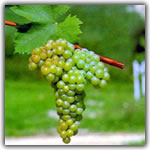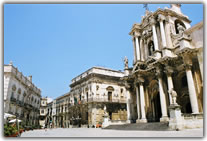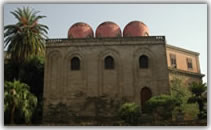| |
|
|
|
|
SicilyWine.
Stories and Legends from the Kitchen to the Cellar - 2 © |
|
|
|
|
|
THE OLDEST WINE OF THE MEDITERRANEAN SEA: THE MOSCATO DI SIRACUSA
 Wine, as it is known, has been diffuse since ancient times. In fact, instances of wine citation reach back to the Babylonian age of Gilgamesh. Perhaps the oldest known sample, an amphora containing traces of wine, was found in Ajii Firuz, Armenia, in the form of a biconical vase dating back to the year 3,500 BC. The first traces of wine cultivar in the Mediterranean sea originated at some point during the IV Millennium on the island of Cyprus (Erimi and Pygros), where the wine vase was invented and later evolved into the Roman amphora, the most commonly used receptacle of the ancient era, and the best method of its time for the preservation and transportation of wine. Wine, as it is known, has been diffuse since ancient times. In fact, instances of wine citation reach back to the Babylonian age of Gilgamesh. Perhaps the oldest known sample, an amphora containing traces of wine, was found in Ajii Firuz, Armenia, in the form of a biconical vase dating back to the year 3,500 BC. The first traces of wine cultivar in the Mediterranean sea originated at some point during the IV Millennium on the island of Cyprus (Erimi and Pygros), where the wine vase was invented and later evolved into the Roman amphora, the most commonly used receptacle of the ancient era, and the best method of its time for the preservation and transportation of wine.
The myth and the legend of Moscato or Pollio of Syracuse. Homer and Hesiod described it thusly: "sweet, graciously scented and most suave... the only example where poetry and lyrics converge in the memory of time...”
Moscato di Siracusa is derived from a variety of grapes originating in the Caucasus, and is the oldest known variety among whites.
The Greeks called it "Anathelicon moschaton", and they cultivated and exported the grapes throughout the Mediterranean. The Siceliot (ancient Sicilians) referred to the grape as "Pollio", also known as "Biblino", a name that comes from Pollio Argivio, the king who ruled the Greek colony of Syracuse.
Wine for a perfect "symposium".
In ancient Greek society, wine had a fundamental role in the symposium (from etymological root, syn- + posis, meaning “ to drink together”) because it facilitated both profound meditation and interpersonal relationships.
Wines were often diluted with water, honey and spices in order to render it more palatable, except for the Moscato, which did not require much tampering and was likely very similar then as it is today. Once considered a luxury item afforded almost exclusively to nobility, enjoying this wine today allows the rest of us  to share the experience the same kind of sensation those ancient peoples revered: " ...intense, persistent, fine, vast and ethereal, with a hint of honey, candied fruit and white withered flowers". to share the experience the same kind of sensation those ancient peoples revered: " ...intense, persistent, fine, vast and ethereal, with a hint of honey, candied fruit and white withered flowers".
Moscato lovers. Among famous historical figures and favorable appraisers of various time periods we find Frederick II, the Emperor of Sicily (XIII Century) who loved Syracuse for the beauty of its landscape and the bounty of its vineyards, and who built there a castle which he named, "Solacium". More recently, the XIX Century Italian composer Giacomo Rossini and XX Century American writer Henry Dumas, were among the many who visited Syracuse for the pleasure of taking in the physical and ethereal beauty of the place, as well as taste the famous Moscato of Syracuse, decanted by the ancient poets so long ago. |
|
|
|
|
|
POPULATUM, MAMERTINUM, TAUROMENITANUM: THE FIRST DOC
The first famous Sicilian wines of which we have historical information were the Populatum, Mamertinum, and Tauromenitanum. These first DOC wines of the Roman period were produced in the vineyards of the central region of Sicily, between the modern-day cities of Enna and Caltanissetta, which were most likely the property of the wealthy family that resided in the famous Villa Romana del Casale, in the small city of Piazza Armerina, during the IV century, B.C.
During the Roman era, Sicilian wine was exported throughout the territory of “Caput Mundi”, and, according to various documentation of the period, even beyond the boundary of Gaul. |
|
|
|
|
|
HOW THE ANCIENT ROMANS AND BYZANTINES DRANK WINE
 Although the drink was known for several centuries, wine was surely not that which it is today. Wine was often diluted with water, and, at times, sweetened with honey or pieces of fruit. However, their preservation methods were so primitive that the wines were impossible to keep, and quickly turned acidic. According to Varrone (III century B.C.), there were fifty types of table grapes and one hundred eighty-five different vines to testify to the commercial success of this acidic drink. Although the drink was known for several centuries, wine was surely not that which it is today. Wine was often diluted with water, and, at times, sweetened with honey or pieces of fruit. However, their preservation methods were so primitive that the wines were impossible to keep, and quickly turned acidic. According to Varrone (III century B.C.), there were fifty types of table grapes and one hundred eighty-five different vines to testify to the commercial success of this acidic drink.
However, the methods of wine production and preservation became ever more advanced over the years, with much of the refinement due in large part to the Byzantines, who were in Sicily from 535 to 827 A.D., and the ecclesiastic wine culture, which was reserved to the priests.
In the convents and churches, wine was drunk in its pure state, and was of optimal quality. Indeed, the wine of the Christian Era assumed a profound religious significance, and was considered the blood of Christ during the weekly liturgy. |
|
|
|
|
|
A.D. 500: MALVASIA, THE OLDEST DESSERT WINE IN THE WORLD, ARRIVES
Malvasia, today’s oldest dessert wine, and still considered elegant and prestigious, came from Greece, Monenvasia in Peloponnesia, to be precise, and enjoyed great success for centuries. |
|
|
|
|
|
THE ARABS. ZIBIBBO, SPAGHETTI AND CASSATA
The Arabs arrived in Sicily in approximately 827, landing on the Southwestern coast, and founded a city that they called Marsala, from the Arabic Mars-Allah, meaning “Port of God”, and with them, they brought a vine called Zibibbo. The Arabs were not drinkers, by any means, seeing as their Islamic religion prohibited them from consuming wine or other alcohol. However, they did much to the benefit of Sicily, bringing many goods and other riches.
Skilled philosophers, mathematicians, and engineers, the Arabs constructed many buildings and mosques of notable beauty, as well as canals for irrigation and the plantation and cultivation of many new plants, including pistachio, carob, asparagus, saffron, cinnamon, clove, and cane sugar.
Their dietary laws also had a strong influence on the Sicilian population’s way of eating, inventing dishes and introducing delicacies that, even today, are present on Sicilian tables all over the world.
 Arabs immediately appreciated the versatility of durum wheat seeds, introducing Cuscus, and with the same talent, began producing maccheroni, or the first pasta. The first spaghetti, produced in Trabia, near Palermo, in the year 900, were called itria. Contrary to common belief, this “invention” of pasta as we know it in the western world was introduced long before Marco Polo’s arrival in Venice at the end of the 13th century from Cathay (China). Arabs immediately appreciated the versatility of durum wheat seeds, introducing Cuscus, and with the same talent, began producing maccheroni, or the first pasta. The first spaghetti, produced in Trabia, near Palermo, in the year 900, were called itria. Contrary to common belief, this “invention” of pasta as we know it in the western world was introduced long before Marco Polo’s arrival in Venice at the end of the 13th century from Cathay (China).
Legend attributes the invention of the famous Sicilian dish,
pasta con le sarde, to an Arab cook by the name of Eufemio, who lived near Syracuse. This dish, a meal unto itself, consists of pasta (preferably bucatini) and sardines marinated with wild fennel and pine nuts, ingredients omnipresent in Sicilian cuisine, and optimal against intoxication.
The union of fresh sheep’s milk ricotta, which had already been produced for centuries by local farmers, and sugar, packed into a copper pot that the Arabs referred to as Quas’at was the origin of the dessert known today as Cassata Siciliana.
A jubilation of colors and sweetness, with a fantastical garnish of candied fruit, the cassata, a cake layered with sweetened ricotta and chocolate, and topped with sugar icing and marzipan, is surely an icon of Sicilian cuisine.
Roberto Alaimo, writer, journalist, philanthropist offers some insight into the invention of the Cassata as we know it today:
The invention of a tradition
"There was a pastry chef from Palermo called Gulì, who, at the end of the nineteenth Century, decided he needed a specialty. At that point, his pastry kitchen on Corso Vittorio Emanuele began producing candied fruit on a near-exclusive basis. Like many Sicilians of tenacious mind, he set out to contradict a most deep-rooted opinion. Much like today, the reaction of a public faced with candied fruit at that time was predictable: repugnance. Nobody wanted it. Were it present, people were sure to separate and discard each piece with careful disdain. The reason why Gulì convinced himself of the contrary, and believed that a candied fruit boom was on its way, remains unknown. The fact was that his pastry kitchen was soon crammed with butternut squash confection and preserved mandarin oranges. With his warehouse full and his business on the verge of bankruptcy, he had an epiphany, an idea that allowed him to recycle his fruit of God's grace. He took his cue from a dessert of very ancient origin- the cassata- in the version of his day, which we would now refer to as “cassata al forno” ("baked ricotta") and went from there: a shell of “pasta frolla”, or pastry crust, dusted with cinnamon and powdered sugar, guarding a core of ricotta and chocolate. With this as a base, he worked from his imagination, and dressed the dessert with baroque style, pouring a sugar icing over the whole thing and mounting candied fruit on top as a garnish. Anyone was now free to ditch the decoration and savor the rest. The result was promptly named “Cassata Siciliana” so as to eliminate even a shade of competition from the most modest original cassata, which had suddenly lost its identity. The luck of the newborn dessert, and its inventor, was to have found a tremendous promotional vehicle. The wealthy Florio family, which hosted royalty and aristocracy in Palermo from all over Europe, chose this new cassata as their signature gift. These guests of the Florio family left Palermo as involuntary testimonials, convinced that this colored mass of sugars represented the true Sicily. Instead, it embodied only the facade."
(Excerpt from “The Art of Getting Moving”, L’arte di Annacarsi, a book to be released this March)

See the complete recipe
Sciarbat or sorbetto is another invention credited to the Arabs of Sicily. At that time, sciarbat was made with actual snow, which was mixed with a sweet, frozen beverage, and flavored with the essences of fruit, vanilla, and cinnamon. Turkish coffee, or qahve, was also used as a spice for flavoring sweets. |
|
|
|
|
|
|
|
|
|
|
|
|
|
|
|
|
|
|
| |
|
| |
1.
2.
3.
4.
5.
6.
7.
8.
9.
10.
11.
12.
13.
14.
15.
16.
17.
18.
19.
20.
21.
22. |
Preface
From the ancient Greeks to... Sicilywine.com
Wine for the spirit...olive oil for the body: the Greek Myths
The arrival of the vines and the legend of Dionysus
Ulysses and Polyphemus...a legendary drink
The oldest wine of the Mediterranean Sea: the Myth of Moscato di Siracusa
Populatum, Mamertinum, Tauromenitanum: the first DOC
How the ancient Romans and Byzantines drank wine
A.D. 500: Malvasia, the oldest dessert wine in the world, arrives
The Arabs. Zibibbo, spaghetti and cassata
Jewish Vegetables: Persian Eggplant or “Parmigiana”
The Normans: Federico II, White Wines and Agrodolce
The Second Millenium and the Advent of the Wooden Barrels
The French, the Aragonese, and the Internationalization of Sicilian Wines
De Naturali Vinorum, History and the Tavernieri
The Legend of Saint Lucy, "Arancini" and "Panelle"
The Beautifully sweet illusion of the “Martorana fruit” or “Marzipan”, and Procopio
From the Spanish to the Florios
Woodhouse. Nelson. Whitaker. The English tradition in "Sicilywine"
From Spaghetti alla Norma to Marsala "Dolce Garibaldi"
The Florio Family
SICILYWINE.COM: Where tradition meets the future...
|
|
|
|
|
|
|
|
|